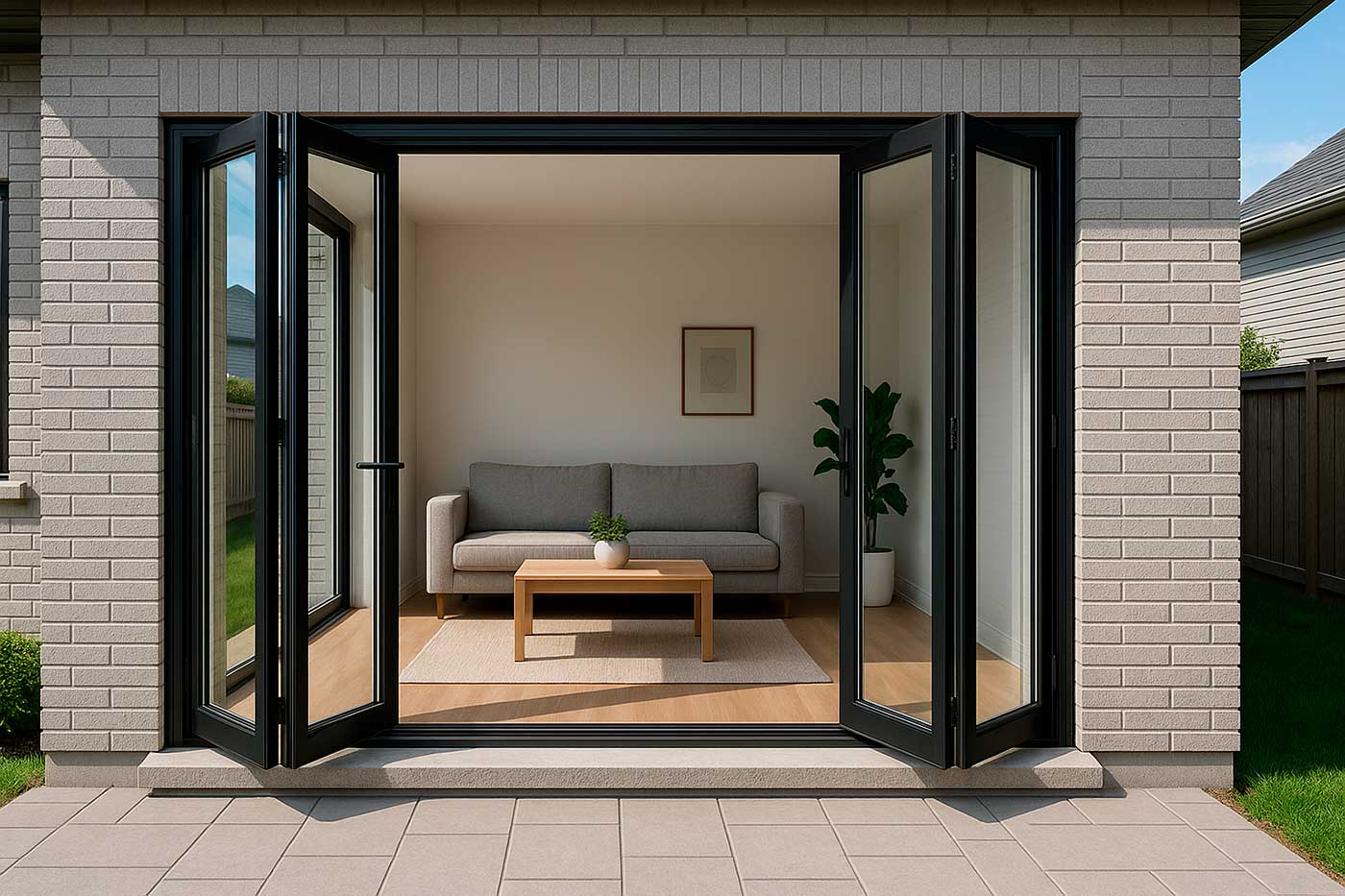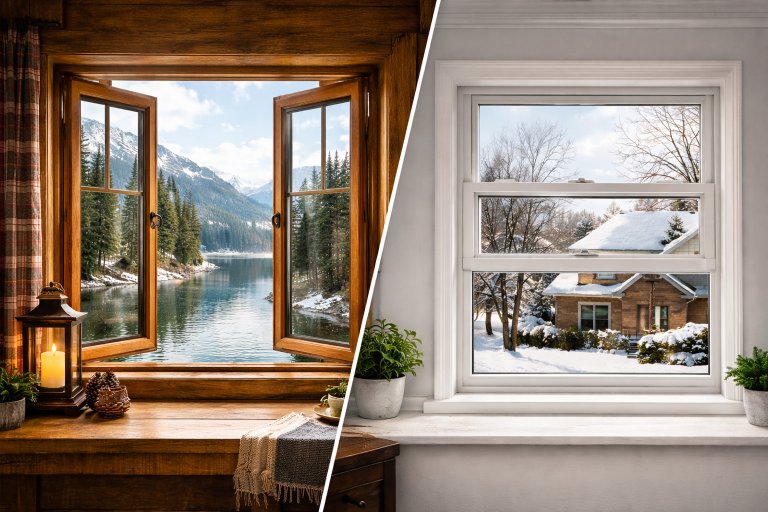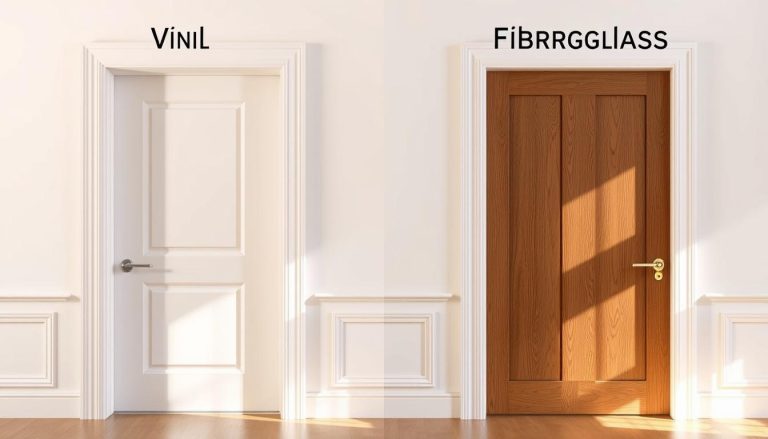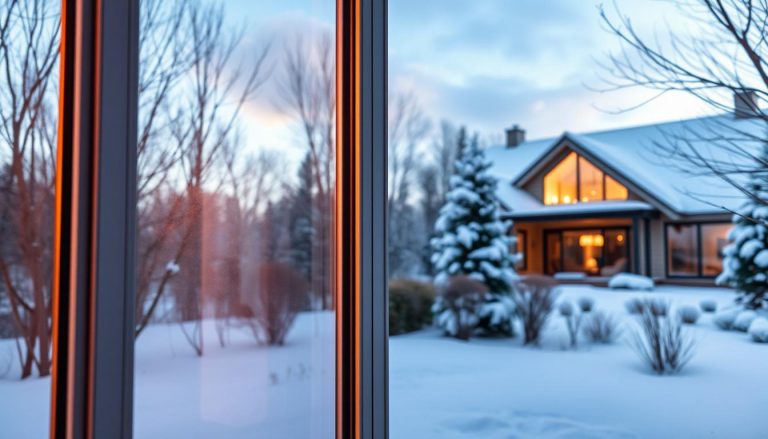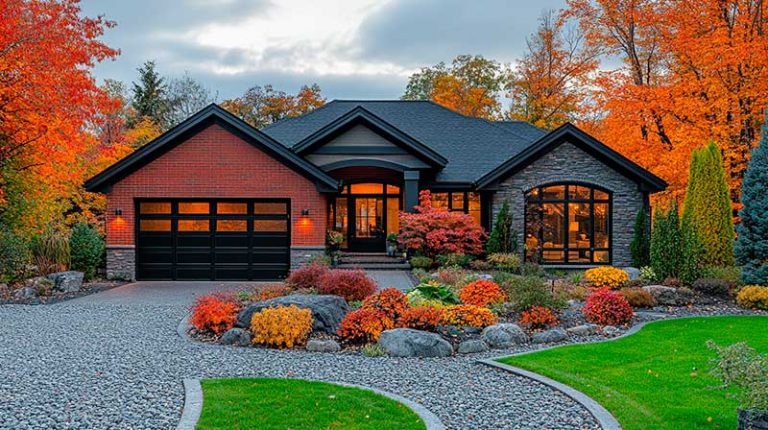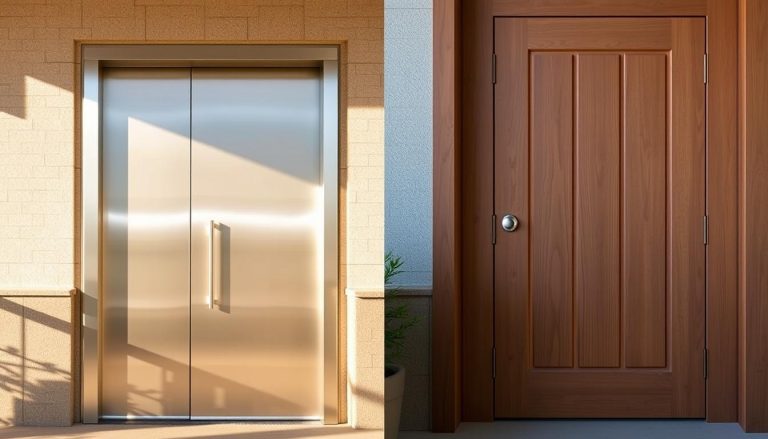As a project manager at Total Home Windows and Doors with years of experience in the Greater Toronto Area, I’ve helped countless homeowners select the perfect bifold doors for their spaces. Whether you’re looking to maximize natural light, save space, or create a seamless indoor-outdoor transition, understanding bifold door sizes is crucial for a successful installation.
"The beauty of bifold doors lies in their versatility. They can transform any space by creating an expansive opening while taking up minimal space when folded." — Cherry Jian, Sales Consultant
Window Replacement Near Me
What is the minimum width and height for bi-fold doors?
When considering doors that fold for your home, knowing the minimum dimensions is essential to determine if bifold doors are right for your space.
The minimum measurements typically accepted by most manufacturers are:
- Minimum width: 60-70 inches (approximately 1.5-1.8 meters)
- Minimum height: 60-70 inches (approximately 1.5-1.8 meters)
Standard doors are typically about 2.1 m tall, so keep in mind that 1.5 m is 0.6 m shorter than this. At Total Home Windows and Doors, our custom manufacturing capabilities allow us to accommodate smaller openings in certain situations.
"We often see customers who want bifold doors for small closets or unique spaces. Our engineering team can create solutions for openings that might be considered too small by industry standards." — Eugene Siukayev, Project Manager
Remember that the minimum size is typically determined by the practicality of the door operation. Extremely narrow bifold doors may not fold properly or provide adequate access to the space behind them.
Measuring for Bifold Doors
Accurate measurements are absolutely critical when ordering bifold doors. Even small measurement errors can result in doors that don’t fit properly.
Step-by-Step Measuring Guide:
- Assess the aperture: Measure the full opening where the doors will be installed.
- Allow for fitting tolerance: Always deduct half an inch from your measurements to ensure the door will fit smoothly.
- Check if the opening is level: Use a large spirit level to verify the opening is square. Measure the diagonals of the opening – they should be equal if the opening is perfectly square.
- Take the smallest measurements: If the opening varies slightly in width or height (common in older homes), use the smallest measurements to ensure proper fit.
Measurement Considerations Table:
| Measurement Area | What to Consider | Why It's Important |
| Width | Measure in three places: top, middle, and bottom | Walls may not be perfectly straight |
| Height | Measure in three places: left, center, and right | Floors and headers may not be level |
| Depth | Consider space for tracks and door swing | Ensures clearance when operating |
| Diagonals | Measure from corner to corner in both directions | Indicates if the opening is square |
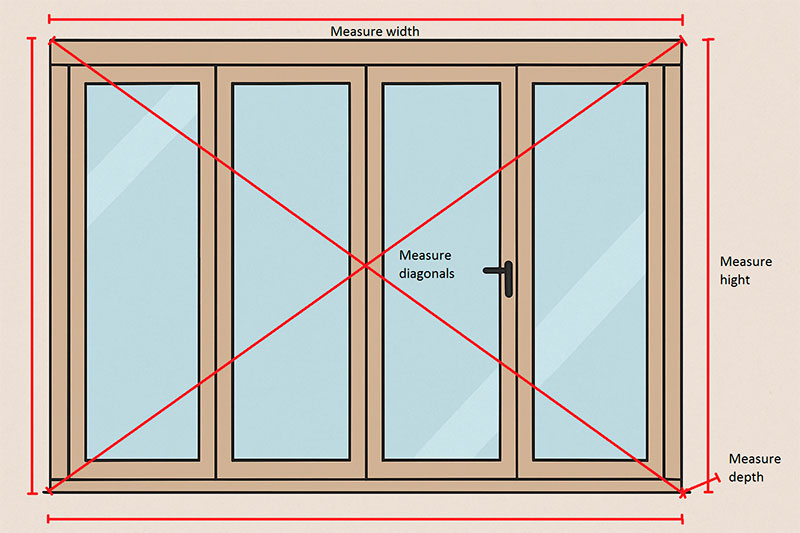
For the most accurate results, we strongly recommend having a building professional take the measurements. At Total Home Windows and Doors, we offer free measuring services to ensure your custom door will fit perfectly.
"In my 14 years in this industry, I've seen more installation problems caused by incorrect measurements than by any other factor. When measuring for bifold doors, precision isn't just important—it's everything." — Daniel Klein, Project Manager
What are the common sizes for bifold doors?
While custom sizes are always an option, understanding standard bifold door sizes can help with initial planning and budgeting.
Standard Widths:
- 1.8m (approximately 71 inches)
- 2.1m (approximately 83 inches)
- 2.4m (approximately 94 inches)
- 2.7m (approximately 106 inches)
Standard Height:
- 2095mm (approximately 82.5 inches)
These standard sizes work well for most residential applications, but commercial spaces often require larger dimensions.
Standard Bifold Door Sizes Chart:
| Configuration | Width Range | Typical Height | Recommended for |
| 2 panels | 1.5-1.8m | 2095mm | Small closets, narrow openings |
| 3 panels | 1.8-2.7m | 2095mm | Standard closets, small room dividers |
| 4 panels | 2.4-3.6m | 2095mm | Large closets, medium patio openings |
| 5+ panels | 3.0m+ | 2095mm | Large openings, patio doors, garden access |
When ordering, always specify measurements in millimeters, not centimeters, for maximum precision. This level of detail ensures optimal energy efficiency and security for your bifold door installation.
"In my 14 years in this industry, I've seen more installation problems caused by incorrect measurements than by any other factor. When measuring for bifold doors, precision isn't just important—it's everything." — Daniel Klein, Project Manager
Custom Bifold Door Sizes
At Total Home Windows and Doors, we believe your home deserves doors that fit perfectly. That’s why we specialize in custom bifold door manufacturing.
Standard Bifold Door Sizes Chart:
"In my 14 years in this industry, I've seen more installation problems caused by incorrect measurements than by any other factor. When measuring for bifold doors, precision isn't just important—it's everything." — Daniel Klein, Project Manager
Benefits of Custom Bifold Doors:
Our custom bifold doors can be manufactured up to 2400 x 1200mm per panel, allowing for significant flexibility in design. Larger configurations are possible by combining multiple panels.
Custom vs. Standard: Pros and Cons
Custom Bifold Doors
Standard Bifold Doors
If you’re interested in custom bifold doors, take advantage of our free measure and quote service. Our experts will help you choose the right size and material for your specific needs.
"When we transitioned to manufacturing our own vinyl windows in 2023, we gained incredible flexibility in creating custom solutions. Now we can offer truly bespoke bifold doors that other companies simply can't match." — Eugene Siukayev, Project Manager
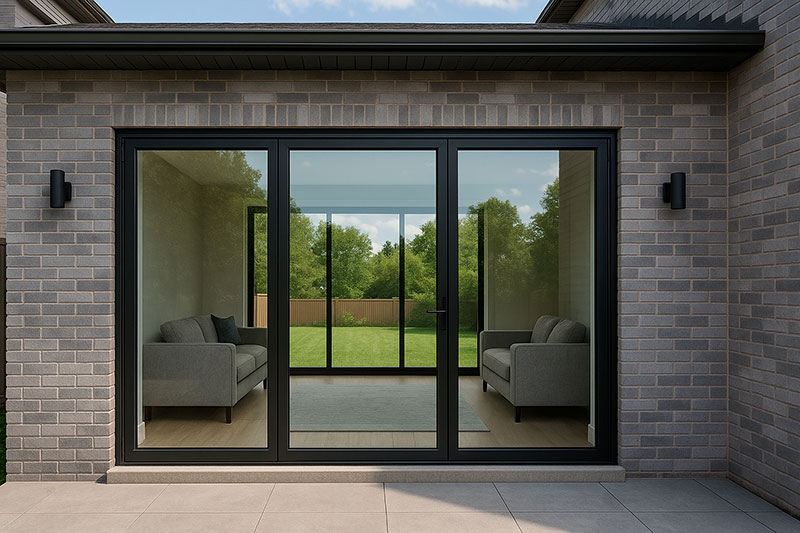
Bifold Door Panel Sizes
The individual panel sizes of your bifold door system will directly impact both functionality and aesthetics.
Panel Size Considerations:
- Width: Typical panel widths range from 400mm to 1000mm
- Height: Standard heights range from 1800mm to 2400mm
- Weight: Larger panels are heavier and may require more durable hardware
- Material impact: Glass panels have different size limitations than wood or aluminum panels
The configuration you choose will determine the size of each panel. For example, in a 4-panel bifold door system for a 3-meter opening, each panel would be approximately 750mm wide.
Maximum Panel Sizes by Material:
| Measurement Area | What to Consider | Why It's Important |
| Width | Measure in three places: top, middle, and bottom | Walls may not be perfectly straight |
| Height | Measure in three places: left, center, and right | Floors and headers may not be level |
| Depth | Consider space for tracks and door swing | Ensures clearance when operating |
| Diagonals | Measure from corner to corner in both directions | Indicates if the opening is square |
Our customers often find that 600-700mm panel widths provide the best balance between ease of operation and minimizing the number of panels needed.
"In my 14 years in this industry, I've seen more installation problems caused by incorrect measurements than by any other factor. When measuring for bifold doors, precision isn't just important—it's everything." — Daniel Klein, Project Manager
Choosing the Right Bifold Door Configuration
The configuration refers to how many panels your bifold door has and how they fold. The minimum is two panels, and there is technically no maximum, though practical considerations usually limit most installations to 8 panels.
Popular Bifold Door Configurations:
| Ideal for | Width range | |
| 2-0 (Two panels folding one way) | Small closets, pantries | 60-75 inches |
| 3-0 (Three panels folding one way) | Medium closets, small room dividers | 75-110 inches |
| 4-0 (Four panels folding one way) | Large closets, medium room dividers | 100-160 inches |
| 3-3 (Six panels, split in middle, folding to each side) | Large room dividers, patio doors | 150-240 inches |
Considerations for Different Spaces:
- Small closets: 2-panel configurations work well, with a bottom track for stability
- Room dividers: 4 or more panels provide substantial openings
- Exterior applications: Consider a configuration that allows maximum opening with minimal stacked panels
"Many of our customers are surprised by how bifold doors can transform their space. In one project, we replaced sliding doors with bifold doors in a garden setting, and the homeowner gained nearly 30% more usable opening width." — Cherry Jian, Sales Consultant
When deciding on your configuration, consider:
- How much of the opening you want to be accessible when doors are folded
- Where the doors will stack when open
- Whether you need access from both sides
Real-World Applications
Here are some examples of how our customers have used bifold doors in their Greater Toronto Area homes:
- Pantry Storage: 2-panel bifold doors at 60″ width provide full access to storage areas
- Closet Solutions: 3-panel configurations for bedroom closets maximize access while saving space
- Indoor-Outdoor Living: 6-panel bifold doors connecting living rooms to patios create seamless transitions
- Room Dividers: 4-panel bifold doors between dining and living areas offer flexibility
With our expanded product offerings through partnerships with leading European manufacturers in 2024, we now offer an even wider range of bifold door options, including tilt-and-turn varieties that combine the benefits of bifold doors with additional functionality.
Conclusion
At Total Home Windows and Doors, we’re committed to helping you find the perfect bifold door solution for your home. With our engineering background, innovative designs like our Slim Flat Profile technology, and dedication to customer satisfaction, we ensure that every door we install meets our high standards for quality and performance.
Ready to explore bifold door options for your home?
With over 28,000 satisfied customers in our 14 years of operation, we have the expertise to help you find the perfect bifold doors for your space.
Explore more door options in our Sliding Doors Gallery or learn about our Patio Doors for more inspiration.
Frequently Asked Questions About Bifold Doors
How do bifold doors fold and how much space do they require?
Bifold doors fold accordion-style along a track system, with panels stacking neatly to one or both sides when opened. They require minimal swing space compared to traditional doors, making them perfect for limited space applications. The stacked panels typically occupy about 10-15% of the total door width when fully opened.
What are the standard measurements for bifold closet doors?
Standard bifold closet doors typically range from 24-36 inches wide and 80-96 inches tall per two-panel door set. However, the actual size needed depends on your closet opening’s exact measurements. Most closet applications use 30-inch doors for standard bedroom closets, while walk-in closets might use larger configurations.
Can bifold doors be used as interior doors throughout my home?
Absolutely! Bifold doors make excellent interior doors for many applications beyond closets. They’re ideal for laundry rooms, pantries, room dividers, and connecting living spaces. Their space-saving design makes them perfect for areas where traditional swing doors would be impractical.
How do I measure my closet for bifold doors?
Measure the width and height of your door frame opening in three places (top, middle, bottom for width; left, center, right for height) and use the smallest measurements. For proper fit, most people deduct ½ inch from both the width and height to allow clearance for the door set installation.
What's the difference between bifold door actual size and nominal size?
The nominal size is what manufacturers list for marketing purposes (like “36-inch door”), while the actual size is slightly smaller to allow for proper installation. For example, a 36-inch nominal bifold door might have an actual size of 35½ inches. Always confirm exact measurements before purchase.
Are aluminum frames better than vinyl for bifold doors?
Aluminum frames offer slimmer profiles and greater strength, allowing for larger glass panels and more contemporary aesthetics. They’re more durable in exterior applications but cost more than vinyl. Vinyl frames provide better insulation and are more budget-friendly, making them popular for interior applications and closet doors.

